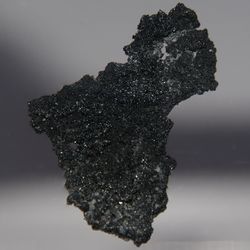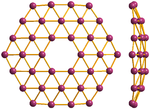بوروفين
بوروفين Borophene هي طبقة أحادية ذرية بلورية من البورون، أي أنها أشكال متآصلة ثنائية الأبعاد للبورون وتُعرف أيضاً بأنها سفحة بورون. وقد توقعها العلماء نظرياً في منتصف ع1990،[1] different borophene structures were experimentally confirmed in 2015.[2][3]
الخصائص
Experimentally various atomically-thin, crystalline and metallic borophenes were synthesized on clean metal surfaces under ultrahigh-vacuum conditions.[2][3] Its atomic structure consists of mixed triangular and hexagonal motifs, such as shown in Figure 1. The atomic structure is a consequence of an interplay between two-center and multi-center in-plane bonding, which is typical for electron deficient elements like boron.[4]
Borophenes exhibit in-plane elasticity and ideal strength. It can be stronger than graphene, and more flexible, in some configurations.[5] Boron nanotubes are also stiffer than graphene, with a higher 2D Young's modulus than any other known carbon and noncarbon nanostructures.[6] Borophenes undergo novel structural phase transition under in-plane tensile loading due to the fluxional nature of their multi-center in-plane bonding.[7] Borophene has potential as an anode material for batteries due to high theoretical specific capacities, electronic conductivity and ion transport properties. Hydrogen easily adsorbs to borophene, offers potential for hydrogen storage – over 15% of its weight. Borophene can catalyze the breakdown of molecular hydrogen into hydrogen ions, and reduce water.[5]
التاريخ
Computational studies by I. Boustani and A. Quandt showed that small boron clusters do not adopt icosahedral geometries like boranes, instead they turn out to be quasi-planar (see Figure 2).[1] This led to the discovery of a so-called Aufbau principle[8] that predicts the possibility of borophene (boron sheets),[1] boron fullerenes (borospherene)[9] and boron nanotubes.[10][11][12]
Additional studies showed that extended, triangular borophene (Figure 1(c)) is metallic and adopts a non-planar, buckled geometry.[13][14] Further computational studies, initiated by the prediction of a stable B80 boron fullerene,[15] suggested that extended borophene sheets with honeycomb structure and with partially filled hexagonal holes are stable.[16][17] These borophene structures were predicted to be metallic. The so-called γ sheet (a.k.a. β12 borophene or υ1/6 sheet) is shown in Figure 1(a).[17]
The planarity of boron clusters was first experimentally confirmed by the research team of L.-S. Wang.[18] Later they showed that the structure of B 36 (see Figure 2) is the smallest boron cluster to have sixfold symmetry and a perfect hexagonal vacancy, and that it can serve as a potential basis for extended two-dimensional boron sheets.[19]
After the synthesis of silicene, multiple groups predicted that borophene could potentially be realized with the support of a metal surface.[20][21][22] In particular, the lattice structure of borophene was shown to depend on the metal surface, displaying a disconnect from that in a freestanding state.[23]
In 2015 two research teams succeeded in synthesizing different borophene phases on silver (111) surfaces under ultrahigh-vacuum conditions.[2][3] Among the three borophene phases synthesized (see Figure 1), the v1/6 sheet, or β12, was shown by an earlier theory to be the ground state on the Ag(111) surface,[23] while the χ3 borophene was previously predicted by Zeng team in 2012.[24] So far, borophenes exist only on substrates; how to transfer them onto a device-compatible substrate is necessary, but remains a challenge.[25]
Atomic-scale characterization, supported by theoretical calculations, revealed structures reminiscent of fused boron clusters consisting of mixed triangular and hexagonal motives, as previously predicted by theory and shown in Figure 1. Scanning tunneling spectroscopy confirmed that the borophenes are metallic. This is in contrast to bulk boron allotropes, which are semiconducting and marked by an atomic structure based on B12 icosahedra.[بحاجة لمصدر]
In 2021 researchers announced hydrogenated borophene on a silver substrated, dubbed borophane. The new material was claimed to be far more stable than its component.[26] Hydrogenation reduces oxidation rates by more than two orders of magnitude after ambient exposure.[27] The creation of two-layer borophene was announced in August 2021. [28]
انظر أيضاً
المراجع
- ^ أ ب ت Boustani, Ihsan (January 1997). "New quasi-planar surfaces of bare boron". Surface Science. 370 (2–3): 355–363. doi:10.1016/S0039-6028(96)00969-7.
- ^ أ ب ت Mannix, A. J.; Zhou, X.-F.; Kiraly, B.; Wood, J. D.; Alducin, D.; Myers, B. D.; Liu, X.; Fisher, B. L.; Santiago, U.; Guest, J. R.; et al. (17 December 2015). "Synthesis of borophenes: Anisotropic, two-dimensional boron polymorphs". Science. 350 (6267): 1513–1516. Bibcode:2015Sci...350.1513M. doi:10.1126/science.aad1080. PMC 4922135. PMID 26680195.
- ^ أ ب ت Feng, Baojie; Zhang, Jin; Zhong, Qing; Li, Wenbin; Li, Shuai; Li, Hui; Cheng, Peng; Meng, Sheng; Chen, Lan; Wu, Kehui (28 March 2016). "Experimental realization of two-dimensional boron sheets". Nature Chemistry. 8 (6): 563–568. doi:10.1038/nchem.2491.
- ^ Pauling, Linus (1960). The nature of the chemical bond (3rd ed.). Cornell University Press. ISBN 0-8014-0333-2.
- ^ أ ب arXiv, Emerging Technology from the. "Sorry, graphene—borophene is the new wonder material that's got everyone excited". MIT Technology Review (in الإنجليزية الأمريكية). Retrieved 2019-08-02.
- ^ Kochaev, A. (11 October 2017). "Elastic properties of noncarbon nanotubes as compared to carbon nanotubes". Physical Review B. 96 (15): 155428. Bibcode:2017PhRvB..96o5428K. doi:10.1103/PhysRevB.96.155428.
- ^ Zhang, Z.; Yang, Yang.; Penev, E.S.; Yakobson, B.I. (11 January 2017). "Elasticity, Flexibility, and Ideal Strength of Borophenes". Advanced Functional Materials. 27 (9): 1605059. arXiv:1609.07533. doi:10.1002/adfm.201605059. S2CID 119199830.
- ^ Boustani, Ihsan (15 June 1997). "Systematic ab initio investigation of bare boron clusters: Determination of the geometry and electronic structures of Bn (n=2-14)". Physical Review B. 55 (24): 16426–16438. Bibcode:1997PhRvB..5516426B. doi:10.1103/PhysRevB.55.16426.
- ^ Boustani, Ihsan (October 1997). "New Convex and Spherical Structures of Bare Boron Clusters". Journal of Solid State Chemistry. 133 (1): 182–189. Bibcode:1997JSSCh.133..182B. doi:10.1006/jssc.1997.7424.
- ^ Boustani, I; Quandt, A (1 September 1997). "Nanotubules of bare boron clusters: Ab initio and density functional study". Europhysics Letters (EPL). 39 (5): 527–532. Bibcode:1997EL.....39..527B. doi:10.1209/epl/i1997-00388-9.
- ^ Gindulytė, Asta; Lipscomb, William N.; Massa, Lou (December 1998). "Proposed Boron Nanotubes". Inorganic Chemistry. 37 (25): 6544–6545. doi:10.1021/ic980559o. PMID 11670779.
- ^ Quandt, Alexander; Boustani, Ihsan (14 October 2005). "Boron Nanotubes". ChemPhysChem. 6 (10): 2001–2008. doi:10.1002/cphc.200500205. PMID 16208735.
- ^ Boustani, Ihsan; Quandt, Alexander; Hernández, Eduardo; Rubio, Angel (8 February 1999). "New boron based nanostructured materials". The Journal of Chemical Physics. 110 (6): 3176–3185. Bibcode:1999JChPh.110.3176B. doi:10.1063/1.477976.
- ^ Kunstmann, Jens; Quandt, Alexander (12 July 2006). "Broad boron sheets and boron nanotubes: An ab initio study of structural, electronic, and mechanical properties". Physical Review B. 74 (3): 035413. arXiv:cond-mat/0509455. Bibcode:2006PhRvB..74c5413K. doi:10.1103/PhysRevB.74.035413. S2CID 73631941.
- ^ Gonzalez Szwacki, Nevill; Sadrzadeh, Arta; Yakobson, Boris I. (20 April 2007). "B80 Fullerene: An Ab Initio Prediction of Geometry, Stability, and Electronic Structure". Physical Review Letters. 98 (16): 166804. Bibcode:2007PhRvL..98p6804G. doi:10.1103/PhysRevLett.98.166804. PMID 17501448.
- ^ Tang, Hui & Ismail-Beigi, Sohrab (2007). "Novel Precursors for Boron Nanotubes: The Competition of Two-Center and Three-Center Bonding in Boron Sheets". Physical Review Letters. 99 (11): 115501. arXiv:0710.0593. Bibcode:2007PhRvL..99k5501T. doi:10.1103/PhysRevLett.99.115501. PMID 17930448. S2CID 30421181.
- ^ أ ب Özdoğan, C.; Mukhopadhyay, S.; Hayami, W.; Güvenç, Z. B.; Pandey, R.; Boustani, I. (18 March 2010). "The Unusually Stable B100 Fullerene, Structural Transitions in Boron Nanostructures, and a Comparative Study of α- and γ-Boron and Sheets". The Journal of Physical Chemistry C. 114 (10): 4362–4375. doi:10.1021/jp911641u.
- ^ Zhai, Hua-Jin; Kiran, Boggavarapu; Li, Jun; Wang, Lai-Sheng (9 November 2003). "Hydrocarbon analogues of boron clusters — planarity, aromaticity and antiaromaticity". Nature Materials. 2 (12): 827–833. Bibcode:2003NatMa...2..827Z. doi:10.1038/nmat1012. PMID 14608377. S2CID 23746395.
- ^ Piazza, Z. A.; Hu, H. S.; Li, W. L.; Zhao, Y. F.; Li, J.; Wang, L. S. (2014). "Planar hexagonal B36 as a potential basis for extended single-atom layer boron sheets". Nature Communications. 5: 3113. Bibcode:2014NatCo...5.3113P. doi:10.1038/ncomms4113. PMID 24445427.
- ^ Zhang, L. Z.; Yan, Q. B.; Du, S. X.; Su, G.; Gao, H.-J. (15 August 2012). "Boron Sheet Adsorbed on Metal Surfaces: Structures and Electronic Properties". The Journal of Physical Chemistry C. 116 (34): 18202–18206. doi:10.1021/jp303616d.
- ^ Liu, Yuanyue; Penev, Evgeni S.; Yakobson, Boris I. (11 March 2013). "Probing the Synthesis of Two-Dimensional Boron by First-Principles Computations". Angewandte Chemie International Edition. 52 (11): 3156–3159. arXiv:1312.0656. doi:10.1002/anie.201207972. PMID 23355180. S2CID 44779429.
- ^ Liu, Hongsheng; Gao, Junfeng; Zhao, Jijun (18 November 2013). "From Boron Cluster to Two-Dimensional Boron Sheet on Cu(111) Surface: Growth Mechanism and Hole Formation". Scientific Reports. 3 (1): 3238. Bibcode:2013NatSR...3E3238L. doi:10.1038/srep03238. PMC 3831238. PMID 24241341.
- ^ أ ب Zhang, Z.; Yang, Y.; Gao, G.; Yakobson, B.I. (2 September 2015). "Two-Dimensional Boron Monolayers Mediated by Metal Substrates". Angewandte Chemie International Edition. 54 (44): 13022–13026. doi:10.1002/anie.201505425. PMID 26331848.
- ^ Wu, Xiaojun; Dai, Jun; Zhao, Yu; Zhu, Zhiwen; Yang, Jinlong; Zeng, Xiao Cheng (20 July 2012). "Two-Dimensional Boron Monolayer Sheets". ACS Nano. 6 (8): 7443–7453. doi:10.1021/nn302696v. PMID 22816319.
- ^ Zhang, Z.; Penev, E.S.; Yakobson, B.I. (31 October 2017). "Two-dimensional boron: structures, properties and applications". Chemical Society Reviews. 46 (22): 6746–6763. doi:10.1039/c7cs00261k. PMID 29085946.
- ^ Lavars, Nick (2021-04-06). "2D "borophane" offers new building block for advanced electronics". New Atlas (in الإنجليزية الأمريكية). Archived from the original on April 6, 2021. Retrieved 2021-04-09.
- ^ Li, Qiucheng; Kolluru, Venkata Surya Chaitanya; Rahn, Matthew S.; Schwenker, Eric; Li, Shaowei; Hennig, Richard G.; Darancet, Pierre; Chan, Maria K. Y.; Hersam, Mark C. (2021-03-12). "Synthesis of borophane polymorphs through hydrogenation of borophene". Science (in الإنجليزية). 371 (6534): 1143–1148. Bibcode:2021Sci...371.1143L. doi:10.1126/science.abg1874. ISSN 0036-8075. PMID 33707261. S2CID 232199843.
- ^ Liu, Xiaolong; Li, Qiucheng; Ruan, Qiyuan; Rahn, Matthew S.; Yakobson, Boris I.; Hersam, Mark C. "Borophene synthesis beyond the single-atomic-layer limit." Nature Materials (26 August 2021). https://doi.org/10.1038/s41563-021-01084-2


